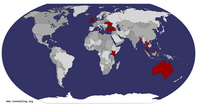COMING SOON HOUSE ADVERTISING ads_leader
Usually disputed lands are fought of over for resources or a strategic purpose. But for the area encompassing Israel, the passionate driver of religion (now mixed with politics) provides the tension. After millennia of habitation, this region is beset by claims, counter-claims and counter-counter-claims over the ownership of holy tracts of earth. So it was into this mix of perpetual tension that I flew to explore a region where religious seeps into the heart of different faiths.
My arrival at Ben Gurion Airport saw an introduction into the reality of disputed domains: Israeli security. All was progressing gently after encountering a kindly female immigration officer who suggested with a thick accent: “Since you are returning to Dubai, do you want me to stamp your boarding pass or passport?” “What do you think is best?” I queried, “I think your boarding pass is best” she replied and with the clunk of the metal stamp, thus not showing any evidence of an Israel visit causing me issues in other countries, I proceeded onwards.
Knowing the high number of Arabic countries that were evidenced by numerous stamps in my worn passport, I was expecting a few pointed questions to be asked by
Israeli security officials, and sure enough, they were asked. Having just left Yemen, I thought this to be the source of most concern, but no, “Why did you visit Syria?” snapped the stoic, stern security officer in reference to my 2008 visit, “To see the tourisms sites of Palmyra and Krak des Chevaliers,” I confidently responded. “Do you know anybody from Syria?” came an equally terse response, “Yes, I did meet lots of Syrians, but do I have contact from anyone in that country now – no.” “So why are you here?” came his next question, “For a pilgrimage,” was my smiling reply. “Enjoy your visit,” was his stoic response, and I was allowed passage into Israel. This animosity to Syria was frequently expressed during my visit, but strangely, people rarely mentioned the threat from Hezbollah in Southern Lebanon, who seem a far greater menace.
The realities of life in Israel became evident on my journey from the airport on a train, which, like most forms of public transport, contained a high proportion of military personnel. I was engaged in conversation with an affable young Israeli male when I espied a sizable number of people marching along a highway.
My new friend informed me that this procession was to show solidarity to Gilad Shalit, the Israeli soldier captured by Hezbollah four years ago. I commented on this impressive display but was informed that this public support could work two ways; though it demonstrates the support for Mr Shalit, it also shows how valuable he is, which could result in Hezbollah increasing their ransom demands to secure his release. Politics is the Middle East is always full of complexities.
My first stop was the seaside port of Akko, otherwise known as Acre in Roman times. Unfortunately for Akko, it was my first tourist destination after the wonders of Old Sana’a and it looked a positively drab by comparison. There were some impressive and lovely sea breezes, but not enough to capture my attention for more than a day. It was interesting that the Palestinians within the town would proudly tell me of their origins so as to differentiate themselves from the Jews – and this occurred throughout Israel. The rest of my time in this area was spent roaming through numerous religious sites (detailed in my next blog) and though religions seemed to intermingle fairly well I did observe
some intolerance, such as the church with the word “Hell” inscribed on its walls in Akko. Overall, Israel felt more secure and stable than neighbouring Lebanon.
The majority of my time was based in Jerusalem. I trembled with excitement when I first stepped through the walls of the Old City, for no other place in the world, barring Rome, has retained its fame for such a prolonged period. The alleys were heaving with mobs of tourists that blocked the narrow passage and traipsing anywhere was a slight challenge. Unfortunately, my time here was negatively impacted by a poor choice of hostel accommodation, as its longer term residents failed to abide by the “silence” rules, and there were no peaceful evening, with people playfully chasing each other and banging on walls; a most unpleasant experience.
One of my first visits was to the Wailing Wall, the most sacred site for Jews. Open to all faiths, one could approach the Wall to see the Hasidic Jews dressed in black garb bobbing and praying. A closer examination of the Wall revealed thousands of prayers crushed into the cracks between the ancient stones. This was a fascinating place to observe the practicing
of faith. Behind the Wall lies the Temple Mount and the Dome of the Rock (Qubbet al-Sakhra), for it is believed that here is where the Prophet Muhammad (peace be upon him) ascended into heaven. This is Jerusalem’s most iconic building, but unless you are Muslim, it was not possible to enter the Dome. This was disappointing considering that such restrictions were not imposed on the religious sites of other faiths.
A vital stop on any itinerary is the Yad Vashem, the Holocaust History Museum. This was a sobering and sensitively presented memorial that detailed the prosecution of the Jews during the Nazi regime in Germany. I witnessed young Israeli army conscripts being taken through the museum, thus reinforcing the importance of their role. The most emotional part of the museum was that dedicated to non-Jews who risked their lives to save Jewish people from the genocide – perhaps a lesson to be taken for those who espouse intolerance for other faiths at the present time. The final room of the Yad Vashem was the Hall of Names, a massive domed area with tomes containing the names and details of 2.2 million victims of the Holocaust. Dwarfed beneath these
books, one could just begin to comprehend its enormity.
I took a day excursion into the Dead Sea, but unfortunately this region in summer is a baking place that shrivels anything within its sphere. The site of Dead Sea Scrolls, Qumran, was interesting from a historical perspective rather than anything of note to see. Thankfully, I was able to inspect some scrolls at Jerusalem's Israel Museum.
The next stop was an essential one in Israel: the once majestic fortress of Masada. Perched high above the surrounding plains, it was the site of the famous siege in 73CE, where when the Romans finally entered the fortress, they discovered that almost all of the 1000 Jews had chosen to die rather than be taken prisoner. I decided on a cable car ride to the summit and walk down the Snake Path, but due to the summer heat, this proved to be a bad error of judgement.
After a few hours wandering the ruins and avoiding the dizzying precipices, I commenced my descent near to midday. Unfortunately, the cooling breeze near the top disappeared once I left the summit, and the more I descended, the hotter it became. The blistering
sun reflecting off the pale stones was so intense that if I were to take a fresh egg and crack one onto the path, it would have cooked before my eyes. There was no shade for respite and I was dangerously close to suffering from heat stroke, so upon reaching the bottom I guzzled a cool bottle of water whilst pouring another one over my head, and sat in a vehicle with the air conditioning blowing it coldest air at full force directly at me. Thankfully I avoided any serious issues but it was uncomfortably close to being a major problem.
The final destination of the day was 10,000 year old city of Jericho. We halted at a Palestinian checkpoint where the nationality of the people in the car was questioned as Jews are not permitted to enter the city. After leaving the checkpoint, two of my fellow passengers revealed themselves as American Jews, and they were most concerned about visiting Jericho, but they were reassured that their American passports would guarantee their passage. Jericho was even hotter than Masada, the heat ensured deserted streets, and I was the only person from the vehicle to brave the conditions to

 Clock in Akko - Israel
Clock in Akko - Israel
Both in Roman numerals and Arabic scriptwalk through all the historical sites.
After my first encounter with the segregation of Israeli Jews and Palestinians in Jericho, I saw a more potent example when passing through the monumental Separation Wall on my journey from Bethlehem. Passing from Jewish held lands was easy enough, but returning was another matter. Within the wall was a deliberately dim confusing maze of walkways with small directional signs. At the identification control, a heavily fortified booth housed security officials, and a condescending female voice boomed from the very loud speakers that echoed through the gloomy interior. From my perspective, the Separation Wall is not only about security, but also involves a degree of humiliation.
My time had come to leave Israel and the departure procedure at Ben Gurion Airport was agonising. It took three hours to pass through a thorough baggage check in which every item was checked and searched (even my soft toy mascots were held by a lady who hand-scanned them for explosives - an odd sight), and I was again subjected to questions about my travels in the country, where I stayed, who I met and what I saw. At least my questions were not as problematic
as the one asked of a Thai national, “Do you speak any Arabic” which could have caused difficulties if asked of me.
With religion and politics as its drivers of conflict feeding an environment of mistrust and suspicion, the chance of an enduring peace in the region is slim but at least tolerance might survive. Perhaps the situation and solution is best summarised by the graffiti on the Palestinian side of the Israeli Separation Wall that read: "Fear Builds Walls, Hope Builds Bridges".
COMING SOON HOUSE ADVERTISING ads_leader_blog_bottom
Tot: 0.115s; Tpl: 0.02s; cc: 14; qc: 34; dbt: 0.072s; 1; m:domysql w:travelblog (10.17.0.13); sld: 1;
; mem: 1.2mb

































feedergoldfish
non-member comment
Knight's Halls
Beautiful picture. Looks to be an amazing sight.